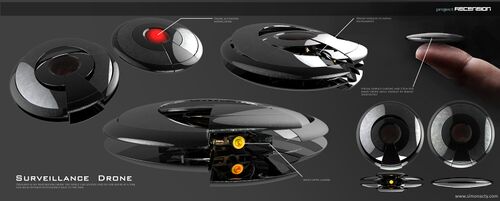There are multiple variants of this technology, please refer to Drone Disambiguation for a list of the variants. |

The short range tactical surveilling drone is only 2.5 cm in diameter. It is powered by a Spacial Variance Reactor at its core powering a simple anti-gravity array allowing it to fly in most environments. It has a range of about 150 km and a maximum speed of around 5 kps. It is designed to be exceptionally small and maneuverable, the built in simple AI seeks out the best vantage point where it can gather the most data.
The official acronym of the devices is SRaTaDr although, colloquially among service members the devices have become known by the nickname of Little Doc SRATA or simply Little Docs.
Deployment
The device is built out of a sensor-resistant material, the size and material make the drone nearly undetectable by most sensors. The drones themselves are keyed to their command and control terminal, typically their launch origin. Though any authorized signal can override this program, the keying process defined a unique encryption key using variable encryption routines in order to establish a secure connection. When keyed together the drones can maximize their effectiveness as a group, usually defined in groups of binary orders of magnitude (2, 4, 8, 16, ...) called a swarm. A drone swarm acts as a single unit with each drone communicating with others it is keyed with to produce a unified force of individual parts. The most common size is 4, though the system can handle a swarm of up to 64 drones working together.
The drones can be deployed from a simple carrying case designed to easily fit in ones pocket measuring 7 cm by 7 cm. The case contains 4 inactive drones that are pre-keyed to work together as a swarm.
Sensors
It has a multi-optic camera that can see in wavelengths of light from the infra-red all the way up to microwaves. Detectors on board can also detect near-by radio and subspace energy sources. Sensor data is relayed back to the source using a subspace datalink, the most data can be transmitted within the 150 km range along with the primary control signal. However, the drone is capable of storing its sensor data for later transmission should communication be cut off temporarily.
Swarm Mapping
The devices can be used to map large areas as a swarm very quickly. Moving together a swarm of 4 devices can successfully map an area 22,500 square kilometers each hour down to a resolution of +/- 1 square millimeter per 1000 square kilometers.
Communications
Due to the size of the drone, it has a limited communications capability. The primary communications array is omnidirectional and has a range of around 150 km. This array can handle real time sensor data and commands / control. The drone also has a secondary array which is a low-bandwidth subspace array which has a greater range (around 424 km) with is not sufficient for real time command / control or the relaying of sensor data. The drone will respond to commands on either array but relies on the secondary array for position tracking and programming updates.
As long as a single drone within a swarm can maintain contact with its primary array, the entire swarm can be controlled as one.
Command / Control
The drone utilizes a simple neural network AI which is able to make basic decisions based on command parameters in set programs. The on board AI is able to run a number of set surveillance programs and able to do minor improvisations based on those programs. Since the AI is limited, the drone works best when being controlled externally and the on board AI is used to either make recommendations or execute simple patterns under the direction of the external controlling terminal.
When outside of the 150 km primary control radius the AI makes decisions based on its selected program and parameters last issued. For simple tasks such as stationary surveillance or tasked with staying within range of a defined target the on board AI is able to make reasonable decisions to not reveal its location and complete the programmed objectives. The AI can be programmed to return to its point of origin to shut down and wait to be retrieved, transmitting a final location before powering down.
Signal Loss
In the event the drone is unable to lock onto a friendly signaling station, it will attempt to return to its host / launch origin. Should that be impossible, it will attempt to land and await further instructions to conserve power and allow the SVR to recharge the energy reserves.